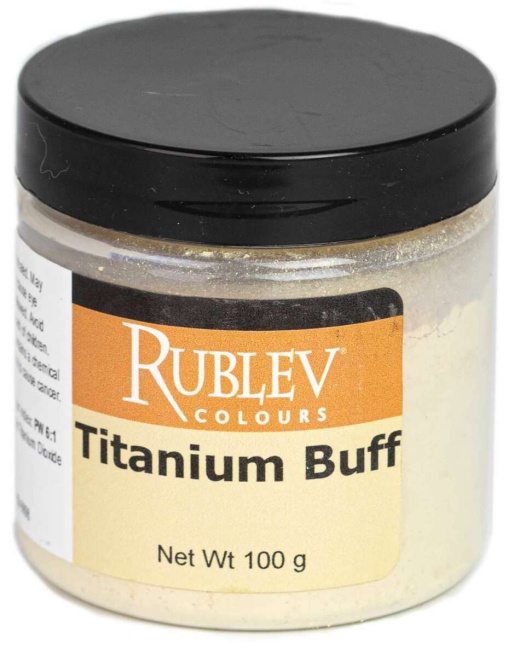Most titanium dioxides are pure white and expensive, but Buff Titanium demonstrates that whiteness is not a prerequisite for effectiveness in color formulations. Here is a comparison of buff titanium to titanium white.
| Buff Titanium | Titanium White |
| • In colored products, offers comparable performance characteristics to titanium white: opacity, consistency, color quality | • Pigment standard for use in white products |
| • Natural ”neutral“ color allows reduction of expensive additional tinting pigments | • In colored products, resulting whiteness must be overcome by tinting with expensive additional color pigments |
| • Reduction of expensive additional further lowers the cost of the finished product | • Additional pigments add cost of the finished product |
| Pigment Nomenclature | |||
| Common Name | Mineral Name | Chemical Name | Source/Origin |
| Titanium buff | Rutile | Titanium dioxide | United States |
Source
Buff titanium pigment is manufactured from an intermediate raw material, synthetic rutile, which is, in turn, made from ilmenite sands. Buff titanium is made from synthetic rutile, incorporating fluid energy milling. During the manufacture of synthetic rutile, high-temperature calcination and strong acid leaching render buff titanium dioxide inactive and inert. The process produces a high-quality pigment, leaving only a tiny percentage of iron oxide.
The small percentage of remaining iron oxide gives buff titanium its natural “buff” color. In the buff titanium process, particles of synthetic rutile mechanically rub each other to form the end product. It is ground to a specified fineness with particles slightly larger and more irregularly shaped than typical titanium dioxide white pigment.
How is Buff Titanium Used?In many products that require opacity and color but that do not have to be pure white, buff titanium can economically replace all or part of the titanium white or other expensive pigments that may be used. Depending on the finished color desired, buff titanium can replace from 15 to 100% of the titanium white used at a cost savings. In addition to replacing titanium white, buff titanium may also allow a reduction of amounts used of phthalo blues and greens, Hansa yellows, organic oranges, synthetic iron oxides, and carbon black (in whole or in part, again depending on the desired color). Buff titanium is chemically inert and considered non-toxic, allowing you to save on your total pigment cost and achieve equal or better opacity, consistency, and color quality.
Applications for Buff TitaniumSome examples of coatings applications in which buff titanium is used widely and successfully are many types of architectural paints, traffic marking paints, automotive and maintenance primers, and coatings for appliances and office furniture. Coating systems that may incorporate buff titanium include alkyds, acrylics, urethanes, and powder coatings. Plastic uses include primarily green, gray, blue, and beige plastic PVC pipe and conduit, vinyl siding, floor tiles, color concentrates, and plastic film.
Buff Titanium may also be used in inks, adhesives, paper, foundry products, and building materials.
Permanence and CompatibilityBuff titanium is a synthetic white pigment rated by the American Society of Testing and Materials (ASTM International) as lightfastness category I, which is the highest lightfastness. It is compatible with all pigments and is resistant to acids and alkalis.
Oil Absorption and GrindingBuff titanium absorbs a low to moderate amount of oil (15 to 25 grams per 100 grams of pigment), which may slow the drying of oil paint and hence is a moderate drying oil color. It disperses well in oil and water-based paints, and compared to titanium white, it is easier to grind due to its slightly larger particle size.
ToxicityBuff titanium is not considered toxic, but care should be taken when handling the pigment. For use in polymeric food contact articles regulated under the Code of Federal Regulations, 21 CFR Part 178.3297 “Colorants for Polymers” 4.1.13.
| Pigment Information | |
| Color: | Buff (Tan) |
| Colour Index: | Pigment White 6:1 (77891) |
| Chemical Name: | Titanium dioxide |
| Chemical Formula: | TiO2 |
| ASTM Lightfastness Rating | |
| Acrylic: | I |
| Oil: | I |
| Watercolor: | I |
| Properties | |
| Specific Gravity: | 3.8 |
| Oil Absorption: | 15–25 g oil / 100 g pigment |
| Median Particle Size: | 1 micron |
| Surface Treatment: | Alumina and silica |
| Crystal Form: | Rutile |
